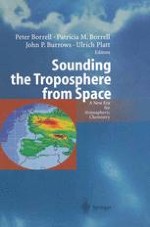2004 | OriginalPaper | Buchkapitel
Global Photochemical Model Evaluation using GOME Tropospheric Column Data
verfasst von : Mark G. Lawrence, T. Kunhikrishnan, Rolf von Kuhlmann
Erschienen in: Sounding the Troposphere from Space
Verlag: Springer Berlin Heidelberg
Enthalten in: Professional Book Archive
Aktivieren Sie unsere intelligente Suche, um passende Fachinhalte oder Patente zu finden.
Wählen Sie Textabschnitte aus um mit Künstlicher Intelligenz passenden Patente zu finden. powered by
Markieren Sie Textabschnitte, um KI-gestützt weitere passende Inhalte zu finden. powered by
The focus of our TROPOSAT-related work has been mainly on comparisons of tropospheric NO2 with output from our global chemistry-transport model MATCH-MPIC. Global monthly NO2 distributions from MATCH-MPIC were compared with GOME NO2 columns in von Kuhlmann (2001). A closer focus on NO2 over Asia has been taken by a joint PhD student with the University of Bremen (T. Kunhikrishnan); the first part of this study has been aimed at improving our understanding of NOX in the troposphere over Asia (especially India), and at developing an improved estimate of the NOX emissions rate from this region, through the use of sensitivity runs with MATCH-MPIC along with GOME tropospheric NO2 columns. We first verified that the retrieval assumptions from GOME (stratospheric zonal symmetry and negligible troposphere NO2 in the Pacific reference sector) hold well for MATCH-MPIC. We then showed that the model simulates the mean NO2 amounts in the region fairly well, and that the NOX lifetime of about 15 hours computed by the model, agrees well with the lifetime derived from the decay of NO2 off the west coast of India. Taken together, these imply that the current total magnitude of NOX emissions in MATCH-MPIC is reasonable. While 60–70 % of the NOX in the lower troposphere over India comes from Indian emissions, in the upper troposphere the NOX comes mainly from outside the region during the winter months and from convective transport and lightning during the summer monsoon.
